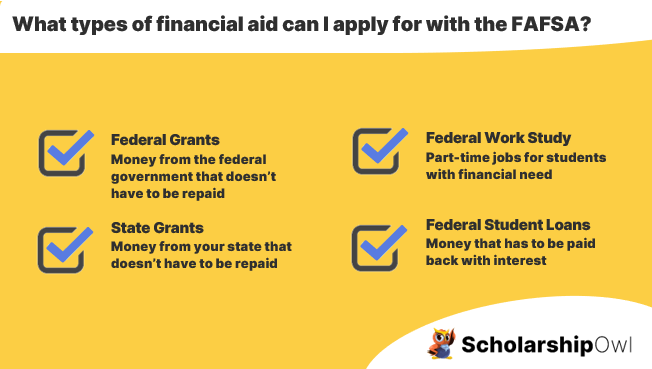Thank you for subscribing!
Most students know that the way to apply for federal student aid is through the FAFSA (Free Application for Federal Student Aid). However, if you have filed a FAFSA in the past few years, it is important to know the following: FAFSA changes.

While some of the changes are fairly minor and have already been implemented over the past few years, the upcoming FAFSA will be very different from the previous FAFSA. Many of the changes are positive, especially for students with significant financial need. However, middle-income students may find this change reduces their chances of receiving federal aid. Check out the FAFSA FAQ below to learn everything you need to know.
What types of financial aid are available on the FAFSA?

When you file the FAFSA, you will be submitting financial data that determines your eligibility for each of the following:
- federal grants – Money that can be used for college tuition and does not have to be paid back. Available grants include Federal Pell Grants, Federal Supplemental Educational Opportunity Grants (FSEOG), Iraq and Afghanistan Service Grants, and Teacher Education Assistance for College and Higher Education (TEACH) grants.
- state subsidy – If your state offers college grants, your state will use the FAFSA to determine whether you qualify for those grants.
- federal research – Part-time jobs for financially disadvantaged undergraduate and graduate students
- federal student loans – Money that can be borrowed to pay for college tuition but must be paid back with interest
Why did the FAFSA change?
Changes were made to the FAFSA for several reasons.
- To simplify and streamline the FAFSA application process
- To improve the accuracy of submitted data
- To reduce the possibility of having to fill out and submit verification documents
- Ensuring federal grant aid targets students with the greatest financial need
Will these changes reduce the number of students eligible for Federal Pell Grants?
no! The good news is that these changes are to be expected. increase Number of students receiving federal Pell grants. In fact, as a result of these changes, an additional 1.5 million students are expected to receive the maximum Pell Grant, bringing the total number of students receiving the maximum amount to 5.2 million. This is because Pell Grant eligibility is tied to family size and federal poverty level, helping to greatly expand access to federal student aid. Additionally, it is expected that more families will decide to complete and submit the FAFSA because it will be faster and easier to complete.
When can I file the FAFSA?

In recent years, the FAFSA opens on October 1st, but for the 2024-25 FAFSA you won’t be able to start filing until late December. The FAFSA is currently scheduled to be launched by December 31, 2023, but it could be delayed until January.
Will filling out the new FAFSA form be easier or more difficult than previous years?
The new FAFSA is simpler and easier to complete. This is great news. There are now 36 questions instead of 108. In fact, depending on your family and income situation, you may only need to answer 18 of the 36 questions.
Why is the new FAFSA completed so quickly? Why are there so few questions now?
The new FAFSA requires automatic transfer of IRS data to the FAFSA. This was available on the old FAFSA for several years, but is now required. Federal income data is transferred automatically, reducing the number of questions you need to ask on the FAFSA form. It also reduces the chance of mistakes and reduces the chance that students will be asked to fill out verification documents later.
How is financial need determined on the new FAFSA?

To determine your financial need, college financial aid officers use a simple equation. In the old FAFSA, “Expected Family Contributions” (EFC) were deducted from the Total Cost of Attendance (COA). As a result, economic needs arose. But the new FAFSA has changed the way financial needs are determined.
- The new FAFSA no longer uses the term “expected family contribution.” The new FAFSA now uses the term “Student Aid Index” (SAI) instead of EFC because students and families found this term confusing. SAI is an eligibility index used by college financial aid officers to determine the amount of federal student aid a student could receive if they attended that school. This number is calculated based on information that students and their families enter on the FAFSA form. SAI works similarly to EFC.
- When calculating financial need, financial aid officers subtract the SAI from the COA and also subtract other financial aid (OFA) to arrive at the student’s financial need. Examples of OFA may include external scholarships, grants, or other financial aid known to the financial aid officer at the time of determining financial need. Therefore, the new formula is COA – SAI – OFA = Financial Needs.
How do I know if I qualify for a Federal Pell Grant through the FAFSA?
After you submit your FAFSA, you will receive a Student Aid Index (SAI) number. This replaces the old Expected Family Contribution (EFC) number. There is one difference between the old EFC and the new SAI. The SAI number may actually be a negative number. If your SAI is between -1500 and 0, you are eligible to receive a Pell Grant of up to $7395. If your SAI number is greater than 0, you may still qualify for a Pell Grant based on your family size, adjusted gross income, and poverty guidelines, but you will receive less than the Pell Grant maximum amount. Possibly.
My parents don’t live together. Do both my parents need to provide financial data on the FAFSA?
For students whose parents are divorced, separated, or unmarried and do not live together, only one parent needs to complete the FAFSA. Previously, parents with whom students lived were most often required to provide financial data on the FAFSA. But with the new FAFSA, the parent who provides you the most financial support is responsible for providing your financial data. Note that if this parent remarries, the stepparent’s income, assets, and dependents will also need to be reported on the FAFSA.
I come from a single parent family. Am I likely to qualify for federal need-based aid?
There is good news for dependent students with only one parent, or independent students who are single parents themselves. The new FAFSA may make you even more eligible for need-based aid. Therefore, while this is a potentially positive change, it is important to note that increased eligibility for students in this situation does not necessarily mean they will be eligible for federal aid. This means you may qualify depending on your household income and assets.
My brother and I are both planning to go to college at the same time. Could we qualify for federal need-based aid?
One of the big changes that will impact families with multiple students at the same time is that the new FAFSA will no longer allow them to “benefit” from this. In other words, if you and your siblings are attending college at the same time, the FAFSA no longer takes that into account in federal financial aid decisions. For low-income households, this doesn’t have a huge impact. However, if you are a middle-income or high-income household, you may find yourself less eligible for federal need-based aid.
What happens after I submit the FAFSA?
If you have recently applied to universities, be sure to keep an eye on the portals of all the universities you have applied to. You should check the Financial Aid section of the portal to see if you need to submit any additional information or verification documents. Please be patient as each university makes scholarship offers. This has always been a difficult wait, but it will become even more difficult in the future as the FAFSA is new and the calculation process has changed, requiring a learning curve for everyone, including financial aid officers. Please note that many universities will not process your financial aid file until they have sent you an offer of admission. This can be frustrating. Private and out-of-state universities may offer scholarships when you apply, but even then, you may not have yet decided whether to receive state or federal aid.
If you are currently attending college, check with your financial aid officer to see if you need to submit any additional information. Please note that the amount of federal aid you receive for the 2024-25 school year may change due to changes to the federal financial aid formula. different What I received this year.
What types of financial aid will appear in my financial aid offer?
Financial aid offers may include a combination of federal and/or state grants, student loans, work study, scholarships, and more. Or it may only include one or two of these. Many students are only offered loans. It all depends on your Student Aid Index (SAI) number and the amount of funds available. If you have recently applied to universities, be sure to understand the complete financial aid and scholarship packages from each university before accepting an offer of admission. If you have any questions, please contact the financial aid office of the college or university you are considering.
I still have questions about the FAFSA. Where can I get additional information?
For more information about the new FAFSA, please visit: Federal Student Aid Website. You can also contact the financial aid office of your university or the university to which you are applying.
Help! I don’t think I can afford to go to university! what can i do?

Many students are worried about not being able to pay for college. However, it is possible to attend college without the burden of student loans. Here’s how:
- To access federal and state grant aid, FAFSA.
- Prioritize scholarship applications scholarship owl.
- Work part-time during the school year and full-time during breaks. Use the money you earn to pay for college tuition.
- Choose a more affordable college, such as starting at a community college.
Remember: Always apply for scholarships and jobs, not loans, so you can graduate debt-free. There is an affordable path to college – for more information and to start applying for a scholarship, visit: www.scholarshipowl.com.